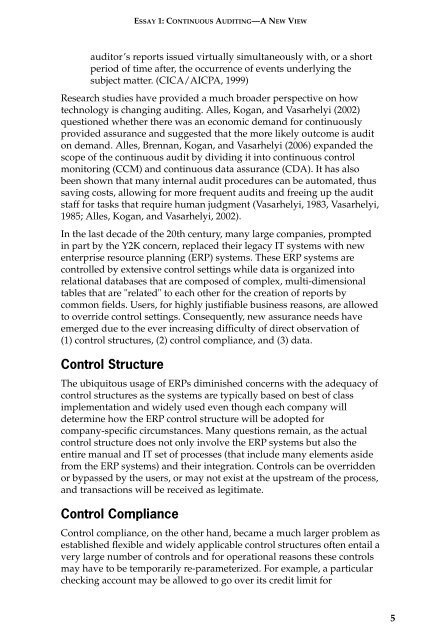AUDIT ANALYTICS AUDIT
1JWn3ix
1JWn3ix
You also want an ePaper? Increase the reach of your titles
YUMPU automatically turns print PDFs into web optimized ePapers that Google loves.
ESSAY 1: CONTINUOUS <strong>AUDIT</strong>ING—A NEW VIEW<br />
auditor’s reports issued virtually simultaneously with, or a short<br />
period of time after, the occurrence of events underlying the<br />
subject matter. (CICA/AICPA, 1999)<br />
Research studies have provided a much broader perspective on how<br />
technology is changing auditing. Alles, Kogan, and Vasarhelyi (2002)<br />
questioned whether there was an economic demand for continuously<br />
provided assurance and suggested that the more likely outcome is audit<br />
on demand. Alles, Brennan, Kogan, and Vasarhelyi (2006) expanded the<br />
scope of the continuous audit by dividing it into continuous control<br />
monitoring (CCM) and continuous data assurance (CDA). It has also<br />
been shown that many internal audit procedures can be automated, thus<br />
saving costs, allowing for more frequent audits and freeing up the audit<br />
staff for tasks that require human judgment (Vasarhelyi, 1983, Vasarhelyi,<br />
1985; Alles, Kogan, and Vasarhelyi, 2002).<br />
In the last decade of the 20th century, many large companies, prompted<br />
in part by the Y2K concern, replaced their legacy IT systems with new<br />
enterprise resource planning (ERP) systems. These ERP systems are<br />
controlled by extensive control settings while data is organized into<br />
relational databases that are composed of complex, multi-dimensional<br />
tables that are "related" to each other for the creation of reports by<br />
common fields. Users, for highly justifiable business reasons, are allowed<br />
to override control settings. Consequently, new assurance needs have<br />
emerged due to the ever increasing difficulty of direct observation of<br />
(1) control structures, (2) control compliance, and (3) data.<br />
Control Structure<br />
The ubiquitous usage of ERPs diminished concerns with the adequacy of<br />
control structures as the systems are typically based on best of class<br />
implementation and widely used even though each company will<br />
determine how the ERP control structure will be adopted for<br />
company-specific circumstances. Many questions remain, as the actual<br />
control structure does not only involve the ERP systems but also the<br />
entire manual and IT set of processes (that include many elements aside<br />
from the ERP systems) and their integration. Controls can be overridden<br />
or bypassed by the users, or may not exist at the upstream of the process,<br />
and transactions will be received as legitimate.<br />
Control Compliance<br />
Control compliance, on the other hand, became a much larger problem as<br />
established flexible and widely applicable control structures often entail a<br />
very large number of controls and for operational reasons these controls<br />
may have to be temporarily re-parameterized. For example, a particular<br />
checking account may be allowed to go over its credit limit for<br />
5


